Towards the end of the working day in Great Britain last Friday afternoon (9th August 2019), a sizeable volume of electricity consumption was cut from the electricity grid as AUFLS (automatic under-frequency load shedding) was triggered. What followed was a bit of a frenzy of interest on formal news media, and also on social media – so much so that it attracted the attention of energy sector nerds and data junkies like me as far away as Australia.
Now it does occur to me that the British might view as a little strange articles like this one posted from afar:
i.e. an Antipodean article, which attempts to piece together a possible sequence of events from scant data, when both:
(1) The official investigation (being completed by National Grid at the request of the regulator, Ofgem) would barely be starting up and would have a long way to run; and also
(2) Whilst Australians have not covered themselves in glory in this energy transition either, both:
(2a) with the SA System Black event itself on 28th September 2016 – and then (perhaps moreso)
(2b) with the 3-year-long-and-counting argument of who/what was at fault and what should be done about that has continued since that time.
However ultimately “curiosity killed this cat” – and I reasoned that guest author Simon Bartlett already posted some initial analysis of a load shed event in Argentina, so WattClarity has some form in looking internationally (and also I thought that any offence taken, though not intended, would not be at the scale of the feelings registered in England following the come-from-behind victory in the 1st Ashes Test just a week ago).
Hence here’s a first – and probably last – grab of what I could piece together from various sources (with what seems like some key questions highlighted in this colour).
(A) Underlying fuel mix at the time of the event
Being the data junkies that we are, we’ve been collecting various data feeds from electricity grids across the world for some time now (including from Elexon in the UK). In the time I have available today, I could quickly dig up this trend of aggregate output by fuel type in the UK:
Note that the time shown on the axis is NEM time (i.e. UTC+10), so you need to translate back to UTC to link to the event.
Noting that the cadence of this data is only every 30 minutes (far from sufficient for a detailed dive into cause-and-effect in cases like these) we can still see the general picture of the supply mix at the time of the event:
1) Aggregate output from wind had ramped up to approximately 8,000MW around the time of the event, which was a big increase from the day before. It’s not possible to discern the trip of the large offshore Hornsea Wind Farm in the data (the data is not granular enough, and the 30-minute time step is too long) but we can see some significant natural variability through the day.
2) As a result, aggregate production from gas had ramped down considerably compared to the day before. Coincidentally, supply from gas on Friday afternoon is also sitting around 8,000MW – and we can see resultant variability in gas output (at least in part compensating for the variability of wind).
3) Nuclear steady at around 6,000MW as it had been all week.
4) We see solar had peaked just below 5,000MW that day (1,000MW below the prior day) and had been ramping down through the afternoon as expected.
5) Hydro generation had ramped up in the afternoon, which I presume had been to supply a late afternoon peak in demand with the solar waning – and we also see a spike of of about 500MW around the time when we suspect the other two units tripped.
6) We see the coal unit that had been running through the week (approx 500MW output) switched off later that evening.
Not included in this image, of course, are either:
1) What the level of consumption was from the grid; and
2) Imports from other grids (mainland Europe, and Ireland) at the time.
Hence it is far from a complete picture.
(B) What might have been the sequence of events
Perhaps moreso than Australia, the UK is blessed with numerous news media outlets, and a number of them were running stories about the load shedding event through Friday evening and into the weekend. With these news media stories, and also selective noting from social media posts (where I think they seem credible – part of the ongoing challenge with social media!) I have tried to piece together the following sequence of events:
Event #1) Sudden drop in generation supply
It seems pretty clear that there were two generators that came offline in quick succession. What caused them to come offline (and whether they were both trips) could not be ascertained at this point.
Event 1a) Little Barford CCGT comes offline – trip, or not?
From what I can gather, Little Barford is a gas-fired CCGT plant which appears to be 737MW in aggregate capacity (across 2 x GE Frame 9FA gas turbines = 241MW each) and a Stein HRSG and Alstom Steam Turbine at 256MW. From what I could find, it looks like the GTs can’t run in isolation from the steam turbine – so similar to some CCGT configurations in the NEM where there is no bypass for the GT exhaust.
In this article “London Blackout Blamed on Drop in Wind and Natural-Gas Power” on the Bloomberg network I read the following:
“RWE said its Little Barford gas station, which has a capacity of 730 megawatts, shut down in line with normal practice when demand hit 23,000 megawatts. National Grid and Ofgem need to investigate what was behind the wider system issues, spokesman Lothar Lambertz said.”
Little Barford (in Bedford) appears to be NNW of London but east of Coventry.
The Bloomberg article (nor any others that I could find) gave a specific time for when the unit came offline – but this article does helpfully include a chart highlighting a drop in output from gas which they attribute to Little Barford coming offline. I am also unclear what the reason was that the unit came offline – was it a trip, or was it some planned maintenance (would seem a little early in the evening for the unit to be coming offline given what I expect the summer demand shape to be net of supply from waning solar that afternoon)?
In any case, energy grids certainly need to be resilient in the case of single large units like this coming offline.
Event #1b) Hornsea Wind Farm comes offline – trip, or not?
Also included in the same article from Bloomberg, we see a rapid drop in aggregate wind output of 1,000MW – which the article suggests happens at 16:50. Other sources note that this happened at the large offshore Hornsea Wind Farm, which from what I gather is a multi-stage project being developed by Orsted (DONG Energy) and Global Infrastructure Partners:
-
- Stage 1 is around 1.2GW and is operational – which implies that the drop in production was probably its whole of its output at the time.
- Stage 2 is around 1.8GW, but I gather still under construction
- Stage 3 is around 1.2GW, and I also gather under construction/development.
Hornsea WF connects into the grid at the 400kV Killingholme substation and appears to be a long way north of Little Barford.
An obvious question for Australian energy nerds (given what might seem some similarities to the linked sequence of events in the SA System Black event) is whether the Wind Farm coming offline was in some way linked to the earlier outage at Little Barford – e.g. perhaps by some form of “fault ride through” issue which was experienced at the sub-set of South Australian Wind Farms that tripped on voltage fluctuations.
-
- Did something similar (i.e. linked) happen with Hornsea, or were the outages entirely coincident (it seems more likely that they were related in some way)?
- An observation I did make in the research process was that the Hornsea turbines happen to be Siemens machines (so the same manufacturer of the turbines used at Hornsdale and Snowtown Wind Farms in South Australia – though this could well be an entirely innocent coincidence).
Event #1c) Other generation units?
There were some discussions I saw on social media about possibly other units being affected, but I’m not sure of the accuracy of those comments so have not included specifics here (though did want to flag them as possibility).
Event #2) Frequency dropped rapidly
When any generation unit comes offline (all else being equal) the system frequency will drop to some extent – those who are a little rusty might appreciate Jonathon Dyson’s handy explainer of why system frequency is so important, and also Allan O’Neil’s prior case study of what happens when a generator trips.
The rate of change of frequency (ROCOF) is inversely related to the amount of inertia available in the grid (all else being equal). Hence a lower inertia grid will experience higher ROCOF – which is one of the reasons why it is of such interest as the NEM progresses through this energy transition.
1) As noted in this other article posted today the level of inertia supplied by synchronous generators in the South Australian region of the NEM had been declining in the South Australian region up until the time of the SA System Black.
2) In our Generator Report Card, we also explore what the trend is for the other mainland regions (the same calculation for Tasmania is more problematic, for reasons explained in the Report Card).
Frequent WattClarity guest author Allan O’Neil obtained a dump of frequency data from www.bmreports.com over the weekend out of curiosity, from which I’ve put together the following image:
We see the frequency drop from the “normal” notional 50Hz level down to a low point of 48.889Hz at 15:53:45 (which implies that the data set is published with a UTC timestamp and not adjusted for daylight savings (a sensible thing to do)). Zooming in more closely to the event time, we see two sequential low points 45 seconds apart:
Note that whilst the two dips on the chart are 45 seconds apart, there is some uncertainty about the specific period between the actual lowest points, because the samples are only of 15 second cadence. Hence they might be further apart (or closer together) than 45 seconds.
As noted on the image, we wonder whether the first low point is entirely the result of the drop in generation from Little Barford coming offline? The frequency drop (from above 50Hz to down near 49.1Hz within 30 seconds – and most of this within 15 seconds) at first glance seems a relatively large change, which suggests other questions about:
Q1) the level of inertia in the grid at the time (noting the lower level of synchronous generation in the grid at this time, compared to others in the week); along with
Q2) the operation of whatever (market-based or other?) frequency raise services were in place at the time. In the NEM these are bundled under FCAS Contingency Raise Service umbrella, but we have not invested time to learn how the arrangements work in the UK and on what time horizons.
The second low point is lower – and could possibly be explained by the secondary trip of the Hornsea Wind Farm (perhaps in response to the rate of change of frequency, or some other disturbance), the effect of which would have counteracted the “raise” effects of whatever frequency support services might have been activated in response to Little Barford coming off.
Event #3) Automated Under-Frequency Load Shedding (AUFLS) kicks in
We presume that at around this point (e.g. frequency dropping below 49Hz perhaps) the AUFLS would have triggered, as a result of which we see the system frequency recover back to 50Hz with (lower) supply and (now lower) demand coming back into balance. This would then have allowed more time for other generators to ramp up, hence allowing all shed load to be reconnected reportedly by 18:30 local time (which would be 17:30 UTC in the frequency plots here).
Interestingly, in this discussion on Twitter over the weekend and today, Glenne Drover (another energy sector nerd with not enough to do on the weekend perhaps?) comments that he had heard that load was lost in addition to what was triggered by the AUFLS protection systems. If you know of which media report this was noted in, feel free to link below as a comment?
I did see this particular note on a BBC news feed at 19:25 on Friday (UK time) quoting Professor Keith Bell at University of Strathclyde noting that the frequency drop had been larger this time around than when there had been a similar loss of supply event in May 2008. One of the possible reasons for this might have been a higher ROCOF resulting from a combination of any or all of the following:
1) More supply being lost, in aggregate
2) Lower inertia in the grid (perhaps because of less synchronous generation); and
3) Lower levels of regulation FCAS support (or whatever it is called in the UK market).
Another interesting contrast to what happened in the SA System Black event was that the AUFLS schemes enabled in South Australia did not have time to operate, as the rate of change of frequency in the (then islanded) South Australian grid was too fast after the Heywood interconnector tripped following the loss of supply from the group of wind farms. This is one of the reasons why level of inertia is important – though, as noted in today’s other article (and in the Generator Report Card), we’re not implying the SA System Black would have been avoided had inertia been higher.
Also worth flagging some similarity to the way in which AUFLS kicked in successfully in the NEM following the rare double-islanding on 25th August 2018.
Event #4) Ofgem asks National Grid to report on the event
This article “Transport chaos across England and Wales after major power cuts” from the Guardian notes that:
“On Friday night, the energy watchdog, Ofgem, warned it could take “enforcement action” over the outage, saying it had demanded an “urgent detailed report from National Grid so we can understand what went wrong”.”
… with the ‘enforcement action’ being something quite familiar to NEM stakeholders, given court action announced by the Australian Energy Regulator only last week with respect to the SA System Black event nearly 3 years ago.
Event #5) The “Energy Wars” get another boost
The energy wars (last discussed here) don’t operate on geographical boundaries – but rather on ideological ones, ratcheted up at both ends by the far-too-influential rumps at both extremes of the Emotion-o-meter, who seem to persist with their ideological wars despite the fact that the more considered people in the middle are more concerned about that train that continues to hurtle down the track.
It did not take some of the broader group of energy sector stakeholders and spectators too long to tie together these two coincident pieces of news from the UK National Grid Operator (i.e. high wind event as a share of total supply mix, followed in the same day by the load shedding):
To paraphrase one of our (many!) recent ex Prime Ministers it seems likely that the high wind conditions probably won’t explain everything that happened with the load shedding events on Friday 9th August in the UK, but then they also probably don’t explain nothing as well. We will have to wait for the more considered (and resourced-up) report from National Grid ESO to understand what actually happened and why…
(C) Other useful media (and other) reports
In no particular order, I found these specific media reports to be of some use in trying to gain an understanding of what happened through Friday:
(C1) From National Grid
As the event was unfolding, and afterwards, National Grid published some useful pieces of information:
1) Julian Leslie, Head of National Control at National Grid ESO published this recorded video message here on Friday;
2) There was this statement published on Saturday;
3) Via the BBC Radio 4, ESO Director Duncan Burt provided an explanation as part of this audio recording (skip to 1:14:26 in the recording) and note that he talks about:
- the automatic protection systems of the generators (i.e. plural) firing, so this would be something further to explore if time permitted.
- other responses (like batteries and demand response) – yet collectively insufficient to prevent the AUFLS schemes triggering.
- … which suggests an N-1 security standard and a single unit tripping being a “credible contingency” but not multiple units tripping.
(C2) From BBC
This image from the BBC provides some useful context to how the lost load was spread across England and Wales (though not Scotland?)
The link in the tweet links through to this article “Major power failure affects homes and transport” on the BBC news site – and that article in turn linked through to this Live Feed of updates (which has ceased now). It was on this page that I’d seen the reference to Professor Keith Bell (image above).
(C3) Other Sources
What follows is a collection of sources that will be added in progressively as they come to hand:
1) On 12th August (UK time) this article “What caused the UK’s power blackout and will it happen again?” was published (by Kathryn Porter?) on the Watt-Logic energy-focused site that explains some things in more detail than I was able to uncover.
2) more, as time permits, and they come to hand…
————————
That’s all I have time to do in analysis of the UK at present – have to start preparing a couple things for the discussions in Sydney on Wednesday evening about the Generator Report Card. See you there!
——————- PS on Tuesday 20th August 2019 ———————
For those who have an interest in understanding more, National Grid has released its “Interim Report into the Low Frequency
Demand Disconnection (LFDD) following Generator Trips and Frequency Excursion on 9 Aug 2019″ here.
Two quick observations:
#1) It was a lightning strike on the network which appears to have triggered the event; and
#2) There were three (not two above) discrete losses of generation supply – independent, but commonly caused by the lightning strike:
2a) Hornsea Wind Farm
2b) Little Barford Gas CCGT
2c) A collection of smaller embedded generation.
Together, this totaled almost 1,900MW – so significantly more than the 1,000MW of “spare” capacity that had been procured under normal conditions.


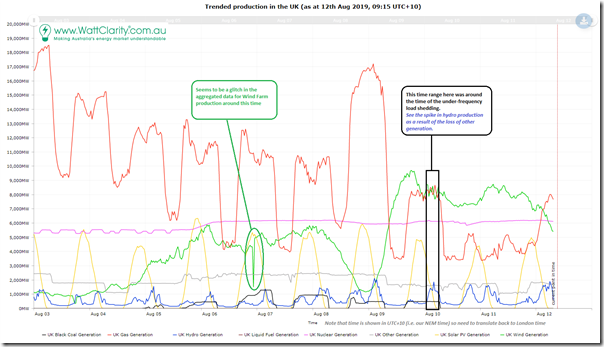
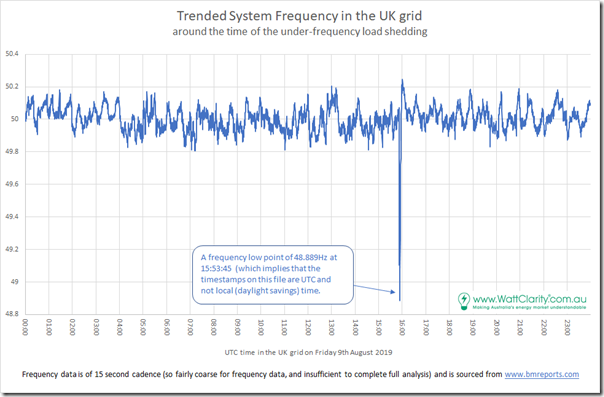
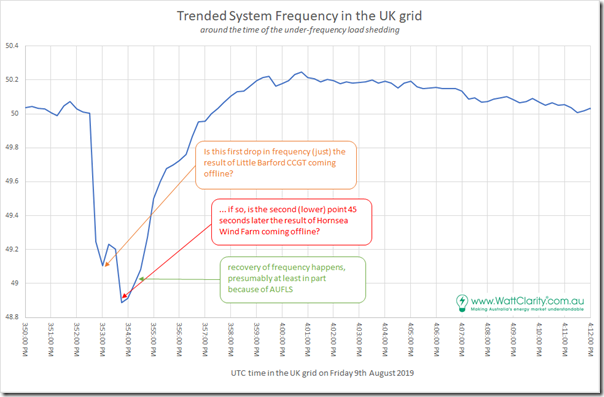
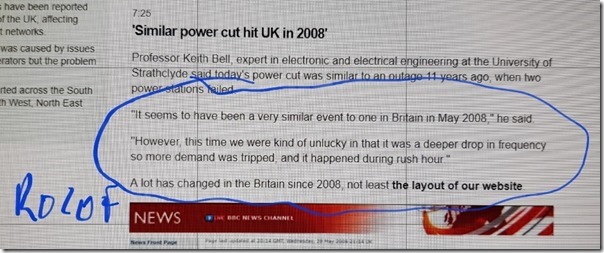
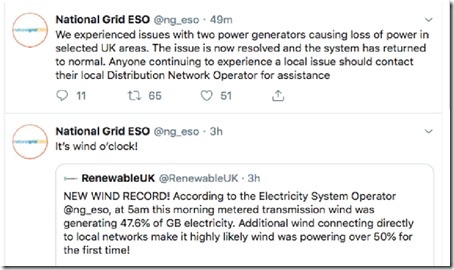
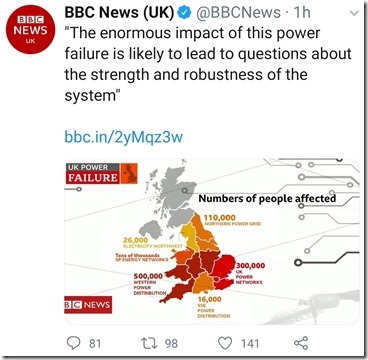
oh, and as a quick PS, readers might also find the comments on this LinkedIn thread useful:
https://www.linkedin.com/feed/update/urn:li:activity:6566537197816766464/
Paul
Nice analysis. We shall have to see what the E(3)C, ESO and Ofgem investigation(s) produce; and how much is published.
Stepping back from the specifics, my own take is that (1) there is inadequate competent strategic oversight of the transition in an industry that tends to predict the future from past experience, and (2) the “energy wars” you describe make this worse. The German experience with frequency-related PV disconnection is another example. I anticipate that the investigation will find that no one body was to blame but they collectively failed to act on a fairly obvious risk.
I am currently looking at the systems implications of the possible transition to EVs in the UK by 2030 (to meet the Fifth Carbon Budget). Lots of opportunity for things to go wrong.
Andrew
Andrew – you absolutely nailed the problem both here and there. As to why there is insufficient competent strategic oversight, well here at least
a) our participants and institutions are almost exclusively mired in detail,
b) our politicians are almost exclusively preoccupied with picking fights and picking winners.
The UK company National Grid is the AEMO of the UK, and is very heavily involved in “The Transition”, i.e. makes a lot of money from all the poles, wires, controls, analysis, etc that is required.
If you regard these events as match-meets-pile-of-wood, you can be sure that any report from National Grid will blame the match for the fire, and will hide the involvement of the pile of wood.
Wind power earlier in the day was 67% of demand, uncharted territory, so claims of great system resilience are specious.
Hi Paul,
Great article. In relation to your question about the UK equivalent of FCAS, National Grid ran a tender process for Enhanced Frequency Response services in ~2016 (1s response time, 4 year contracts offered, taken up by various technologies, many BESS projects). There is more info here:
https://www.nationalgrideso.com/balancing-services/frequency-response-services/enhanced-frequency-response-efr
In addition it looks like they are also trialing the procurement of Firm Frequency Response services (slower response times).
https://www.nationalgrideso.com/balancing-services/frequency-response-services/firm-frequency-response-ffr?overview
It would certainly be interesting to know how the EFR plant performed. Perhaps the capacity just wasn’t sufficient to mitigate the frequency drop.
Thanks to WC for the insightful analysis.
I cannot possibly see how a train wreck can be avoided without mandating that every tenderer of electrons to a communal grid has to be able to reasonably guarantee them 24/7/365 or they can keep them and that includes frequency and voltage. Anything else is delusional State sponsored dumping in my book and normally the ACCC would be all over it for the obvious but alas.
It seems that the initial report on the UK outage has been leaked and it notes the wind turbine failure occured first, which tripped the gas power plant.
https://www.thegwpf.com/leaked-report-points-to-wind-farm-failure-causing-uk-blackout/
“Experts have said giant batteries providing instant back-up energy could help.”…
“The costs are sizeable but if there’s a risk of this happening more frequently, I don’t think businesses or consumers will accept a lower standard of continuity of supply.”
https://www.thisismoney.co.uk/money/news/article-7367413/Renewable-energy-blackout-risk-warns-National-Grid-outage.html
I would think so when it takes 6.8 million pounds for experts to work that out.
This Guardian report would suggest National Grid has a frequency control problem, with three significant frequency excursions in the three months leading up to the event. https://www.theguardian.com/business/2019/aug/12/three-blackout-near-misses-in-three-months-says-national-grid The watt logic article above points out that UK nuclear does not provide a frequency control response, so the amount of MW and MW.s available for Raise regulation may be quite small.